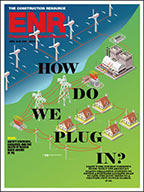At Facebook Inc.’s sprawling 57-acre campus in Menlo Park, Calif., construction professionals met with Silicon Valley technologists in mid-November to discover ways to improve the AEC industry, all in one weekend. Though a first for the construction industry, this kind of innovate-or-bust meeting is popular in the tech world and is known as a "hackathon."
“This is a starting gun for innovation,” says Paul Doherty, who co-founded AEC Hackathon with Damon Hernandez, a 3D web, virtual and augmented reality developer.
Doherty says the idea of the organization is to get programmers and developers from other industries, such as gaming and web design, to "hack," or rethink, the processes they already use to work in the built environment. Once complete, all the work will be open source and available soon at the AEC Hackathon website.
With that goal in mind, on the first night of the event, the 130 attendees divided up into teams and decided what software, hardware or procedural solution to work on. The categories available were digital fabrication, mobile tech, cloud tech, BIM 2.0, digital worlds/smart cities and AEC FutureTech. By the second day, the teams had outlined their goals and were hard at work, hacking. Experts in multiple fields and programming languages were present to answer questions to help speed the innovation. Concurrent to the hacking were presentations and workshops on the same topics the teams were trying to solve.
“It’s been a great experience to have developers who will listen to our problems, instead of trying to tell us what our problems are,” says Klas Berghede, production leader at Boldt Co., Appleton, Wis. His team worked on redesigning an integrated project life-cycle solution.
Several teams worked on web viewers for 3D geometry with attributes such as analysis data or BIM data, says Jonaton Schumacher, director of advanced computational modeling at Thornton Tomasetti.
One of these teams, calling themselves aeChack, developed an open-source platform for running and visualizing environmental analysis using daylighting and energy-analysis engines. It can be found here.
Many attendees said they were impressed with the event and what came out of it. “The projects ranged from tools that did a single task to a complete rethinking of the industry,” says Terry Beaubois, president of Terry Beaubois and Associates, Palo Alto, Calif. If success is measured by imitation, then the hackathon was a success—it already has copycats. Case and Autodesk are now doing a BIM Hackathon at Autodesk University this year in Las Vegas.
Schumacher says, in the past, industry hacking sessions have been done on a smaller scale. “I’ve never been at an event like this with so many programmers, but something like it has happened before with hacky architects,” says Schumacher. “This just makes it more official.”
The AEC Hackathon 2.0 will be held in conjunction with ENR’s FutureTECH conference this March in San Francisco.








